Psychology Report: Color's Influence on Mood and Agitation
VerifiedAdded on 2021/04/21
|15
|3915
|220
Report
AI Summary
This psychology report investigates the impact of color on human mood, specifically examining the effects of red and blue room colors on agitation levels. The research involved an experiment with 20 participants, where their agitation levels were measured while residing in red and blue rooms. The study found that participants exhibited higher agitation levels in red rooms and lower levels in blue rooms, indicating a significant relationship between color and mood. The report includes a literature review, methodology, data analysis using MS Excel, and concludes that blue is better for a serene mood than red. The research employs an experimental design, analyzing the independent variable 'color' and its effect on the dependent variable 'agitation level'. The report highlights the psychological properties of colors, suggesting that blue promotes calmness and red increases stimulation. Finally, the study recommends blue for soothing environments.
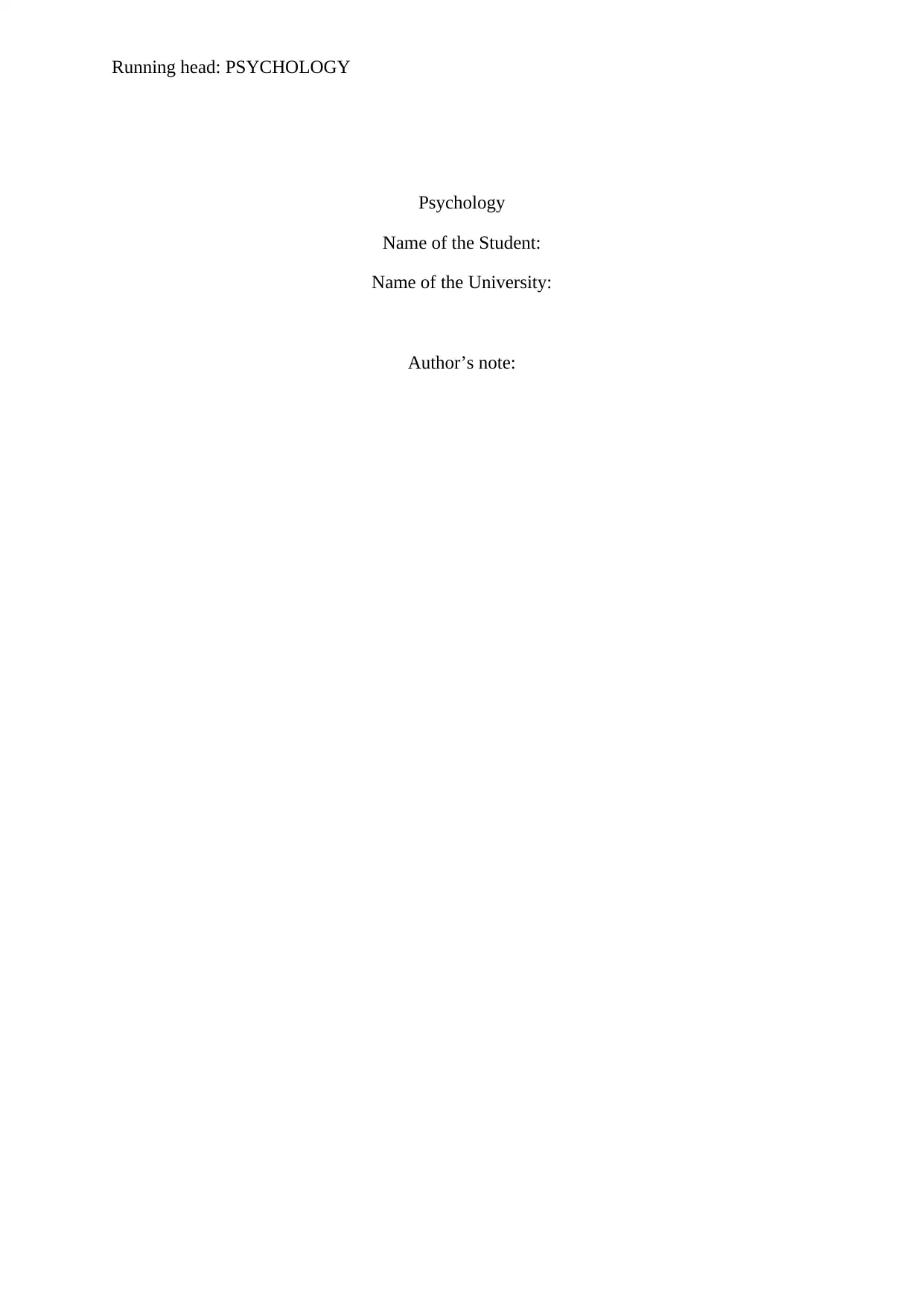
Running head: PSYCHOLOGY
Psychology
Name of the Student:
Name of the University:
Author’s note:
Psychology
Name of the Student:
Name of the University:
Author’s note:
Paraphrase This Document
Need a fresh take? Get an instant paraphrase of this document with our AI Paraphraser
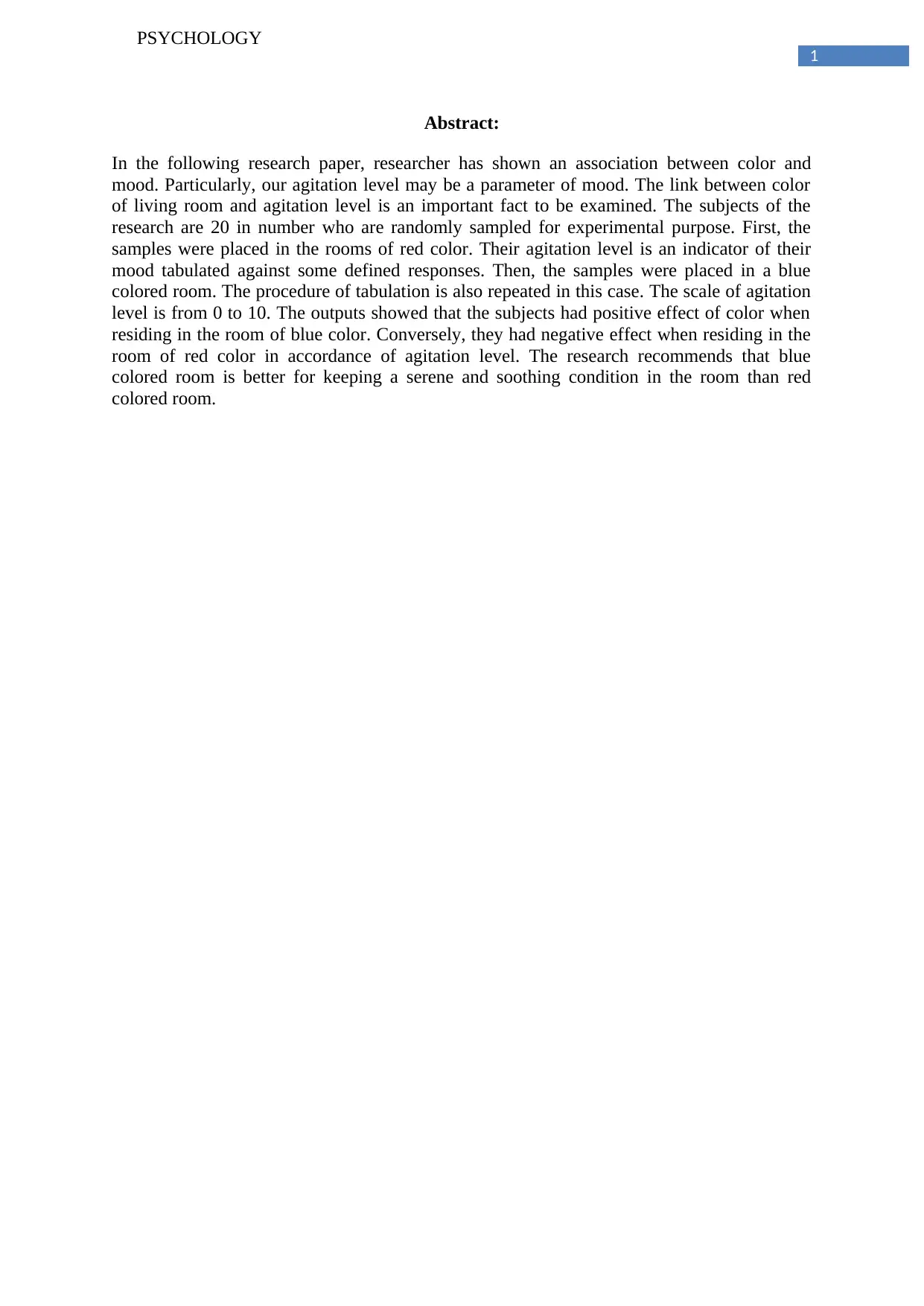
1
PSYCHOLOGY
Abstract:
In the following research paper, researcher has shown an association between color and
mood. Particularly, our agitation level may be a parameter of mood. The link between color
of living room and agitation level is an important fact to be examined. The subjects of the
research are 20 in number who are randomly sampled for experimental purpose. First, the
samples were placed in the rooms of red color. Their agitation level is an indicator of their
mood tabulated against some defined responses. Then, the samples were placed in a blue
colored room. The procedure of tabulation is also repeated in this case. The scale of agitation
level is from 0 to 10. The outputs showed that the subjects had positive effect of color when
residing in the room of blue color. Conversely, they had negative effect when residing in the
room of red color in accordance of agitation level. The research recommends that blue
colored room is better for keeping a serene and soothing condition in the room than red
colored room.
PSYCHOLOGY
Abstract:
In the following research paper, researcher has shown an association between color and
mood. Particularly, our agitation level may be a parameter of mood. The link between color
of living room and agitation level is an important fact to be examined. The subjects of the
research are 20 in number who are randomly sampled for experimental purpose. First, the
samples were placed in the rooms of red color. Their agitation level is an indicator of their
mood tabulated against some defined responses. Then, the samples were placed in a blue
colored room. The procedure of tabulation is also repeated in this case. The scale of agitation
level is from 0 to 10. The outputs showed that the subjects had positive effect of color when
residing in the room of blue color. Conversely, they had negative effect when residing in the
room of red color in accordance of agitation level. The research recommends that blue
colored room is better for keeping a serene and soothing condition in the room than red
colored room.
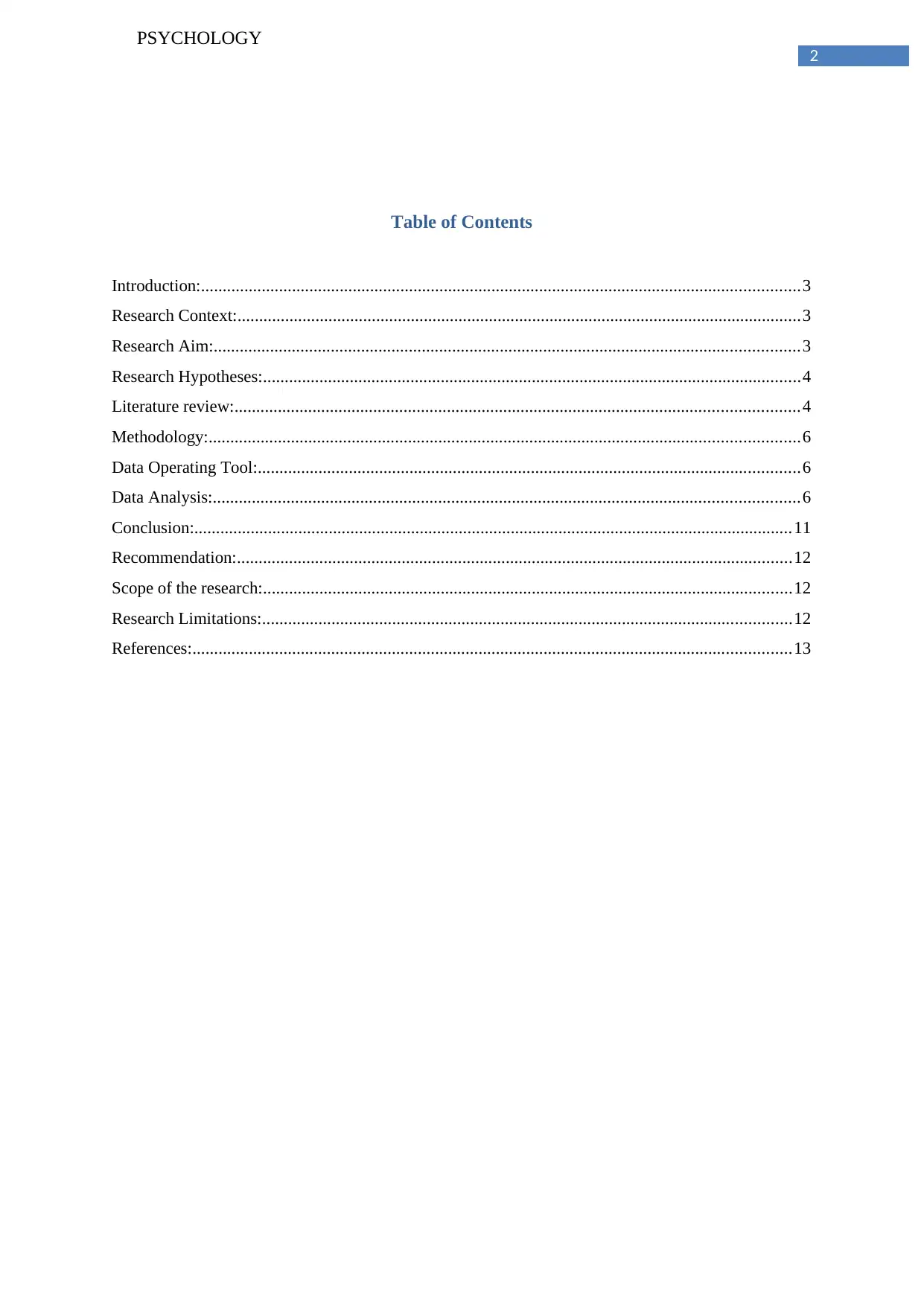
2
PSYCHOLOGY
Table of Contents
Introduction:..........................................................................................................................................3
Research Context:..................................................................................................................................3
Research Aim:.......................................................................................................................................3
Research Hypotheses:............................................................................................................................4
Literature review:..................................................................................................................................4
Methodology:........................................................................................................................................6
Data Operating Tool:.............................................................................................................................6
Data Analysis:.......................................................................................................................................6
Conclusion:..........................................................................................................................................11
Recommendation:................................................................................................................................12
Scope of the research:..........................................................................................................................12
Research Limitations:..........................................................................................................................12
References:..........................................................................................................................................13
PSYCHOLOGY
Table of Contents
Introduction:..........................................................................................................................................3
Research Context:..................................................................................................................................3
Research Aim:.......................................................................................................................................3
Research Hypotheses:............................................................................................................................4
Literature review:..................................................................................................................................4
Methodology:........................................................................................................................................6
Data Operating Tool:.............................................................................................................................6
Data Analysis:.......................................................................................................................................6
Conclusion:..........................................................................................................................................11
Recommendation:................................................................................................................................12
Scope of the research:..........................................................................................................................12
Research Limitations:..........................................................................................................................12
References:..........................................................................................................................................13
⊘ This is a preview!⊘
Do you want full access?
Subscribe today to unlock all pages.

Trusted by 1+ million students worldwide
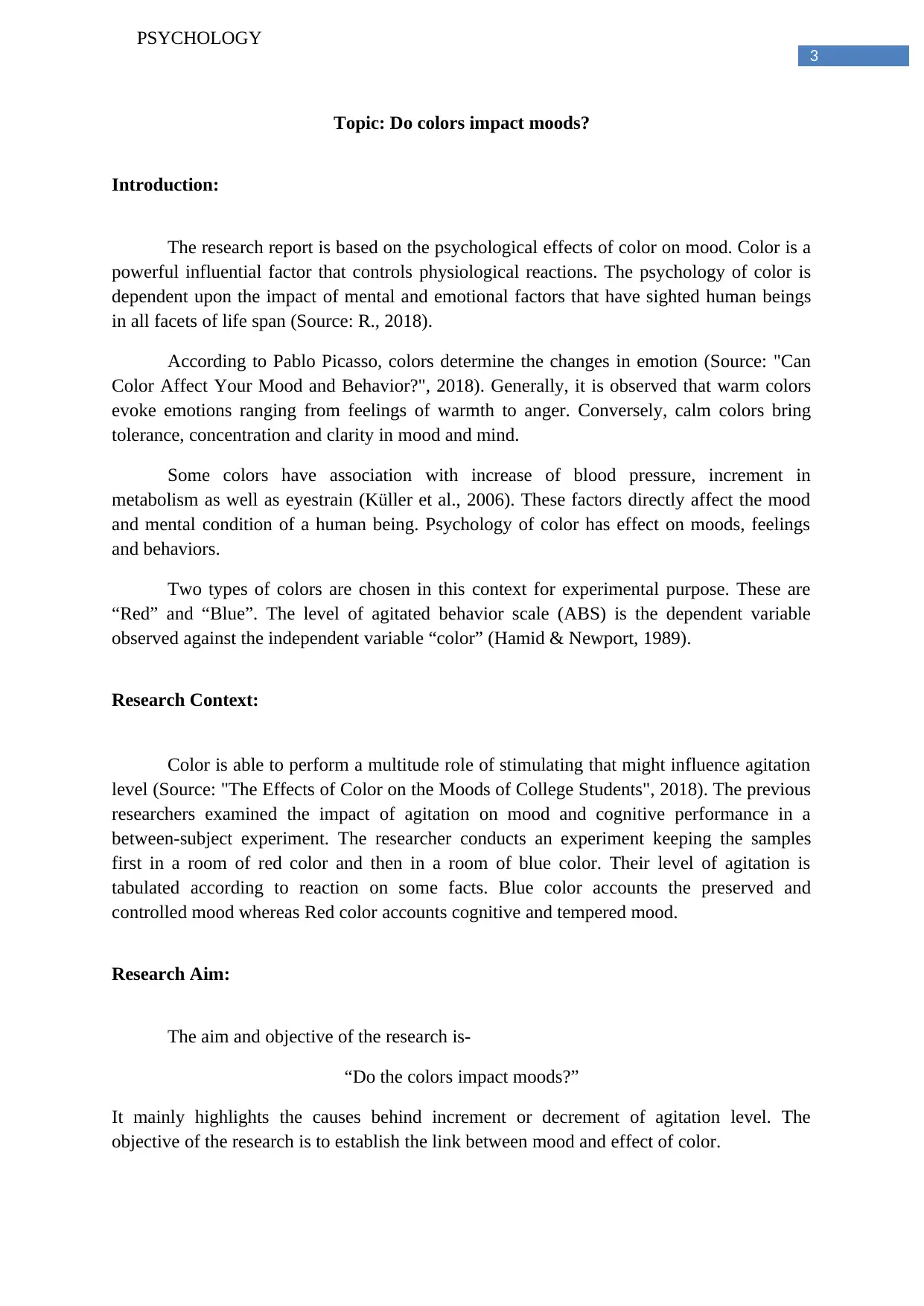
3
PSYCHOLOGY
Topic: Do colors impact moods?
Introduction:
The research report is based on the psychological effects of color on mood. Color is a
powerful influential factor that controls physiological reactions. The psychology of color is
dependent upon the impact of mental and emotional factors that have sighted human beings
in all facets of life span (Source: R., 2018).
According to Pablo Picasso, colors determine the changes in emotion (Source: "Can
Color Affect Your Mood and Behavior?", 2018). Generally, it is observed that warm colors
evoke emotions ranging from feelings of warmth to anger. Conversely, calm colors bring
tolerance, concentration and clarity in mood and mind.
Some colors have association with increase of blood pressure, increment in
metabolism as well as eyestrain (Küller et al., 2006). These factors directly affect the mood
and mental condition of a human being. Psychology of color has effect on moods, feelings
and behaviors.
Two types of colors are chosen in this context for experimental purpose. These are
“Red” and “Blue”. The level of agitated behavior scale (ABS) is the dependent variable
observed against the independent variable “color” (Hamid & Newport, 1989).
Research Context:
Color is able to perform a multitude role of stimulating that might influence agitation
level (Source: "The Effects of Color on the Moods of College Students", 2018). The previous
researchers examined the impact of agitation on mood and cognitive performance in a
between-subject experiment. The researcher conducts an experiment keeping the samples
first in a room of red color and then in a room of blue color. Their level of agitation is
tabulated according to reaction on some facts. Blue color accounts the preserved and
controlled mood whereas Red color accounts cognitive and tempered mood.
Research Aim:
The aim and objective of the research is-
“Do the colors impact moods?”
It mainly highlights the causes behind increment or decrement of agitation level. The
objective of the research is to establish the link between mood and effect of color.
PSYCHOLOGY
Topic: Do colors impact moods?
Introduction:
The research report is based on the psychological effects of color on mood. Color is a
powerful influential factor that controls physiological reactions. The psychology of color is
dependent upon the impact of mental and emotional factors that have sighted human beings
in all facets of life span (Source: R., 2018).
According to Pablo Picasso, colors determine the changes in emotion (Source: "Can
Color Affect Your Mood and Behavior?", 2018). Generally, it is observed that warm colors
evoke emotions ranging from feelings of warmth to anger. Conversely, calm colors bring
tolerance, concentration and clarity in mood and mind.
Some colors have association with increase of blood pressure, increment in
metabolism as well as eyestrain (Küller et al., 2006). These factors directly affect the mood
and mental condition of a human being. Psychology of color has effect on moods, feelings
and behaviors.
Two types of colors are chosen in this context for experimental purpose. These are
“Red” and “Blue”. The level of agitated behavior scale (ABS) is the dependent variable
observed against the independent variable “color” (Hamid & Newport, 1989).
Research Context:
Color is able to perform a multitude role of stimulating that might influence agitation
level (Source: "The Effects of Color on the Moods of College Students", 2018). The previous
researchers examined the impact of agitation on mood and cognitive performance in a
between-subject experiment. The researcher conducts an experiment keeping the samples
first in a room of red color and then in a room of blue color. Their level of agitation is
tabulated according to reaction on some facts. Blue color accounts the preserved and
controlled mood whereas Red color accounts cognitive and tempered mood.
Research Aim:
The aim and objective of the research is-
“Do the colors impact moods?”
It mainly highlights the causes behind increment or decrement of agitation level. The
objective of the research is to establish the link between mood and effect of color.
Paraphrase This Document
Need a fresh take? Get an instant paraphrase of this document with our AI Paraphraser
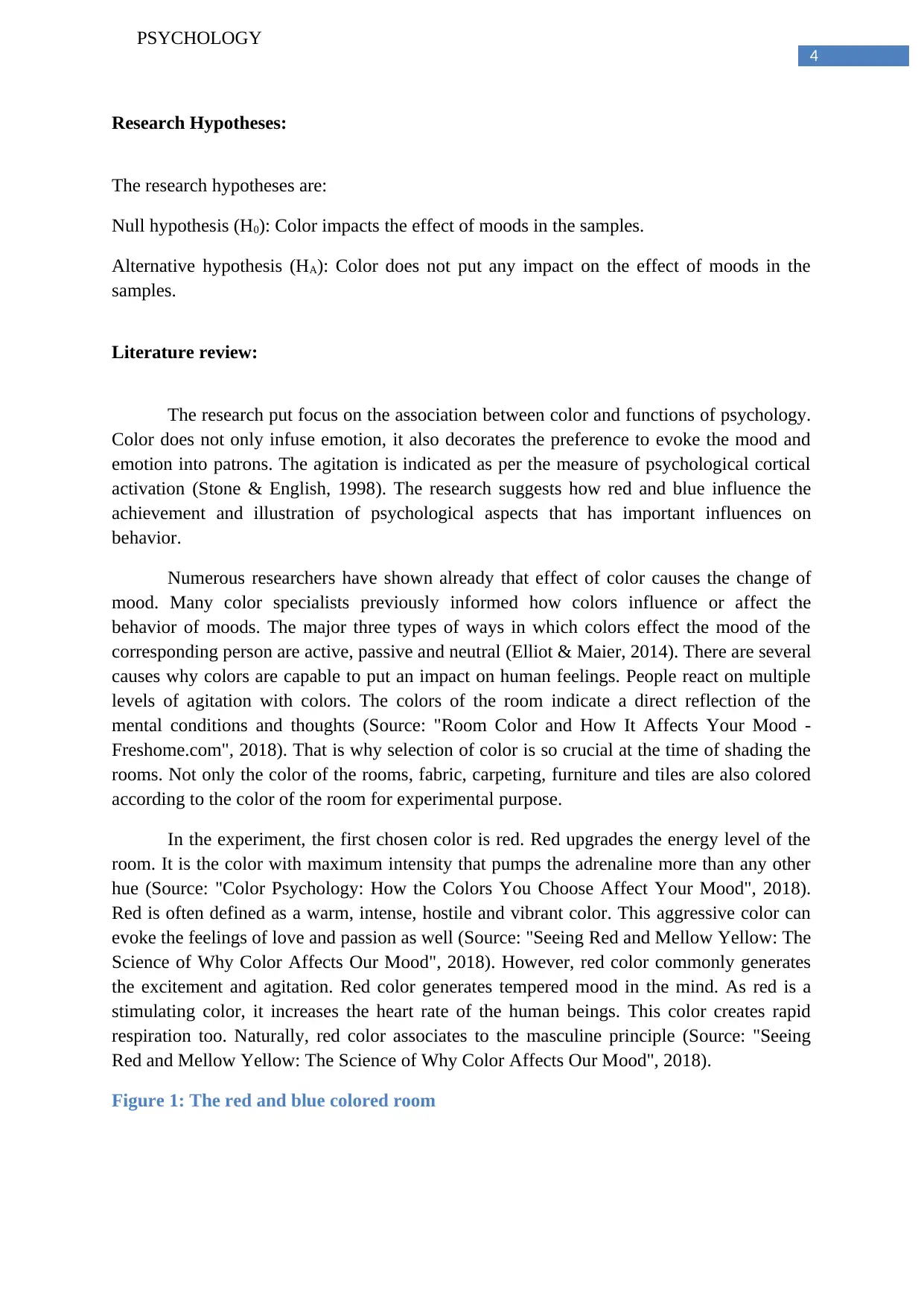
4
PSYCHOLOGY
Research Hypotheses:
The research hypotheses are:
Null hypothesis (H0): Color impacts the effect of moods in the samples.
Alternative hypothesis (HA): Color does not put any impact on the effect of moods in the
samples.
Literature review:
The research put focus on the association between color and functions of psychology.
Color does not only infuse emotion, it also decorates the preference to evoke the mood and
emotion into patrons. The agitation is indicated as per the measure of psychological cortical
activation (Stone & English, 1998). The research suggests how red and blue influence the
achievement and illustration of psychological aspects that has important influences on
behavior.
Numerous researchers have shown already that effect of color causes the change of
mood. Many color specialists previously informed how colors influence or affect the
behavior of moods. The major three types of ways in which colors effect the mood of the
corresponding person are active, passive and neutral (Elliot & Maier, 2014). There are several
causes why colors are capable to put an impact on human feelings. People react on multiple
levels of agitation with colors. The colors of the room indicate a direct reflection of the
mental conditions and thoughts (Source: "Room Color and How It Affects Your Mood -
Freshome.com", 2018). That is why selection of color is so crucial at the time of shading the
rooms. Not only the color of the rooms, fabric, carpeting, furniture and tiles are also colored
according to the color of the room for experimental purpose.
In the experiment, the first chosen color is red. Red upgrades the energy level of the
room. It is the color with maximum intensity that pumps the adrenaline more than any other
hue (Source: "Color Psychology: How the Colors You Choose Affect Your Mood", 2018).
Red is often defined as a warm, intense, hostile and vibrant color. This aggressive color can
evoke the feelings of love and passion as well (Source: "Seeing Red and Mellow Yellow: The
Science of Why Color Affects Our Mood", 2018). However, red color commonly generates
the excitement and agitation. Red color generates tempered mood in the mind. As red is a
stimulating color, it increases the heart rate of the human beings. This color creates rapid
respiration too. Naturally, red color associates to the masculine principle (Source: "Seeing
Red and Mellow Yellow: The Science of Why Color Affects Our Mood", 2018).
Figure 1: The red and blue colored room
PSYCHOLOGY
Research Hypotheses:
The research hypotheses are:
Null hypothesis (H0): Color impacts the effect of moods in the samples.
Alternative hypothesis (HA): Color does not put any impact on the effect of moods in the
samples.
Literature review:
The research put focus on the association between color and functions of psychology.
Color does not only infuse emotion, it also decorates the preference to evoke the mood and
emotion into patrons. The agitation is indicated as per the measure of psychological cortical
activation (Stone & English, 1998). The research suggests how red and blue influence the
achievement and illustration of psychological aspects that has important influences on
behavior.
Numerous researchers have shown already that effect of color causes the change of
mood. Many color specialists previously informed how colors influence or affect the
behavior of moods. The major three types of ways in which colors effect the mood of the
corresponding person are active, passive and neutral (Elliot & Maier, 2014). There are several
causes why colors are capable to put an impact on human feelings. People react on multiple
levels of agitation with colors. The colors of the room indicate a direct reflection of the
mental conditions and thoughts (Source: "Room Color and How It Affects Your Mood -
Freshome.com", 2018). That is why selection of color is so crucial at the time of shading the
rooms. Not only the color of the rooms, fabric, carpeting, furniture and tiles are also colored
according to the color of the room for experimental purpose.
In the experiment, the first chosen color is red. Red upgrades the energy level of the
room. It is the color with maximum intensity that pumps the adrenaline more than any other
hue (Source: "Color Psychology: How the Colors You Choose Affect Your Mood", 2018).
Red is often defined as a warm, intense, hostile and vibrant color. This aggressive color can
evoke the feelings of love and passion as well (Source: "Seeing Red and Mellow Yellow: The
Science of Why Color Affects Our Mood", 2018). However, red color commonly generates
the excitement and agitation. Red color generates tempered mood in the mind. As red is a
stimulating color, it increases the heart rate of the human beings. This color creates rapid
respiration too. Naturally, red color associates to the masculine principle (Source: "Seeing
Red and Mellow Yellow: The Science of Why Color Affects Our Mood", 2018).
Figure 1: The red and blue colored room
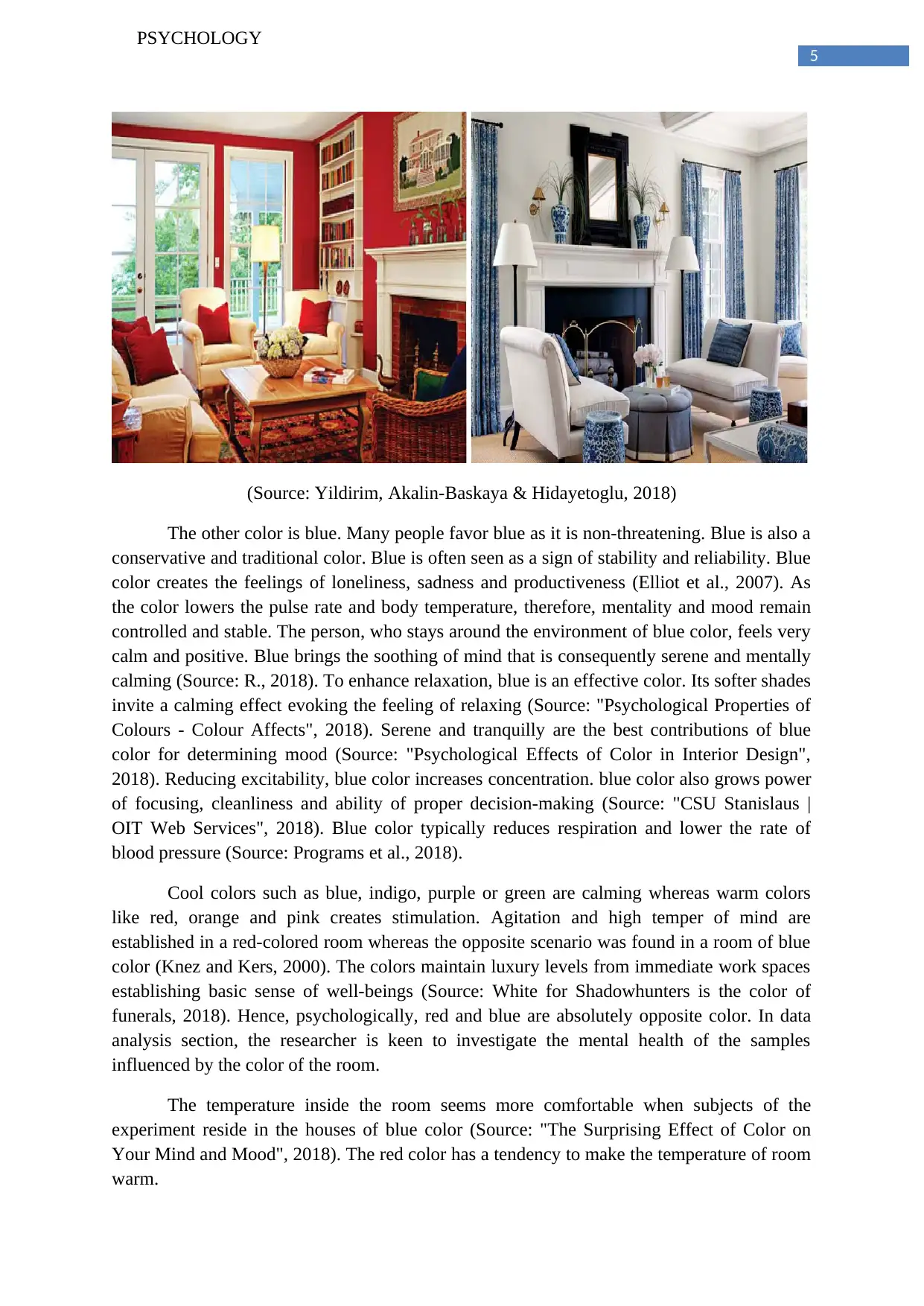
5
PSYCHOLOGY
(Source: Yildirim, Akalin-Baskaya & Hidayetoglu, 2018)
The other color is blue. Many people favor blue as it is non-threatening. Blue is also a
conservative and traditional color. Blue is often seen as a sign of stability and reliability. Blue
color creates the feelings of loneliness, sadness and productiveness (Elliot et al., 2007). As
the color lowers the pulse rate and body temperature, therefore, mentality and mood remain
controlled and stable. The person, who stays around the environment of blue color, feels very
calm and positive. Blue brings the soothing of mind that is consequently serene and mentally
calming (Source: R., 2018). To enhance relaxation, blue is an effective color. Its softer shades
invite a calming effect evoking the feeling of relaxing (Source: "Psychological Properties of
Colours - Colour Affects", 2018). Serene and tranquilly are the best contributions of blue
color for determining mood (Source: "Psychological Effects of Color in Interior Design",
2018). Reducing excitability, blue color increases concentration. blue color also grows power
of focusing, cleanliness and ability of proper decision-making (Source: "CSU Stanislaus |
OIT Web Services", 2018). Blue color typically reduces respiration and lower the rate of
blood pressure (Source: Programs et al., 2018).
Cool colors such as blue, indigo, purple or green are calming whereas warm colors
like red, orange and pink creates stimulation. Agitation and high temper of mind are
established in a red-colored room whereas the opposite scenario was found in a room of blue
color (Knez and Kers, 2000). The colors maintain luxury levels from immediate work spaces
establishing basic sense of well-beings (Source: White for Shadowhunters is the color of
funerals, 2018). Hence, psychologically, red and blue are absolutely opposite color. In data
analysis section, the researcher is keen to investigate the mental health of the samples
influenced by the color of the room.
The temperature inside the room seems more comfortable when subjects of the
experiment reside in the houses of blue color (Source: "The Surprising Effect of Color on
Your Mind and Mood", 2018). The red color has a tendency to make the temperature of room
warm.
PSYCHOLOGY
(Source: Yildirim, Akalin-Baskaya & Hidayetoglu, 2018)
The other color is blue. Many people favor blue as it is non-threatening. Blue is also a
conservative and traditional color. Blue is often seen as a sign of stability and reliability. Blue
color creates the feelings of loneliness, sadness and productiveness (Elliot et al., 2007). As
the color lowers the pulse rate and body temperature, therefore, mentality and mood remain
controlled and stable. The person, who stays around the environment of blue color, feels very
calm and positive. Blue brings the soothing of mind that is consequently serene and mentally
calming (Source: R., 2018). To enhance relaxation, blue is an effective color. Its softer shades
invite a calming effect evoking the feeling of relaxing (Source: "Psychological Properties of
Colours - Colour Affects", 2018). Serene and tranquilly are the best contributions of blue
color for determining mood (Source: "Psychological Effects of Color in Interior Design",
2018). Reducing excitability, blue color increases concentration. blue color also grows power
of focusing, cleanliness and ability of proper decision-making (Source: "CSU Stanislaus |
OIT Web Services", 2018). Blue color typically reduces respiration and lower the rate of
blood pressure (Source: Programs et al., 2018).
Cool colors such as blue, indigo, purple or green are calming whereas warm colors
like red, orange and pink creates stimulation. Agitation and high temper of mind are
established in a red-colored room whereas the opposite scenario was found in a room of blue
color (Knez and Kers, 2000). The colors maintain luxury levels from immediate work spaces
establishing basic sense of well-beings (Source: White for Shadowhunters is the color of
funerals, 2018). Hence, psychologically, red and blue are absolutely opposite color. In data
analysis section, the researcher is keen to investigate the mental health of the samples
influenced by the color of the room.
The temperature inside the room seems more comfortable when subjects of the
experiment reside in the houses of blue color (Source: "The Surprising Effect of Color on
Your Mind and Mood", 2018). The red color has a tendency to make the temperature of room
warm.
⊘ This is a preview!⊘
Do you want full access?
Subscribe today to unlock all pages.

Trusted by 1+ million students worldwide
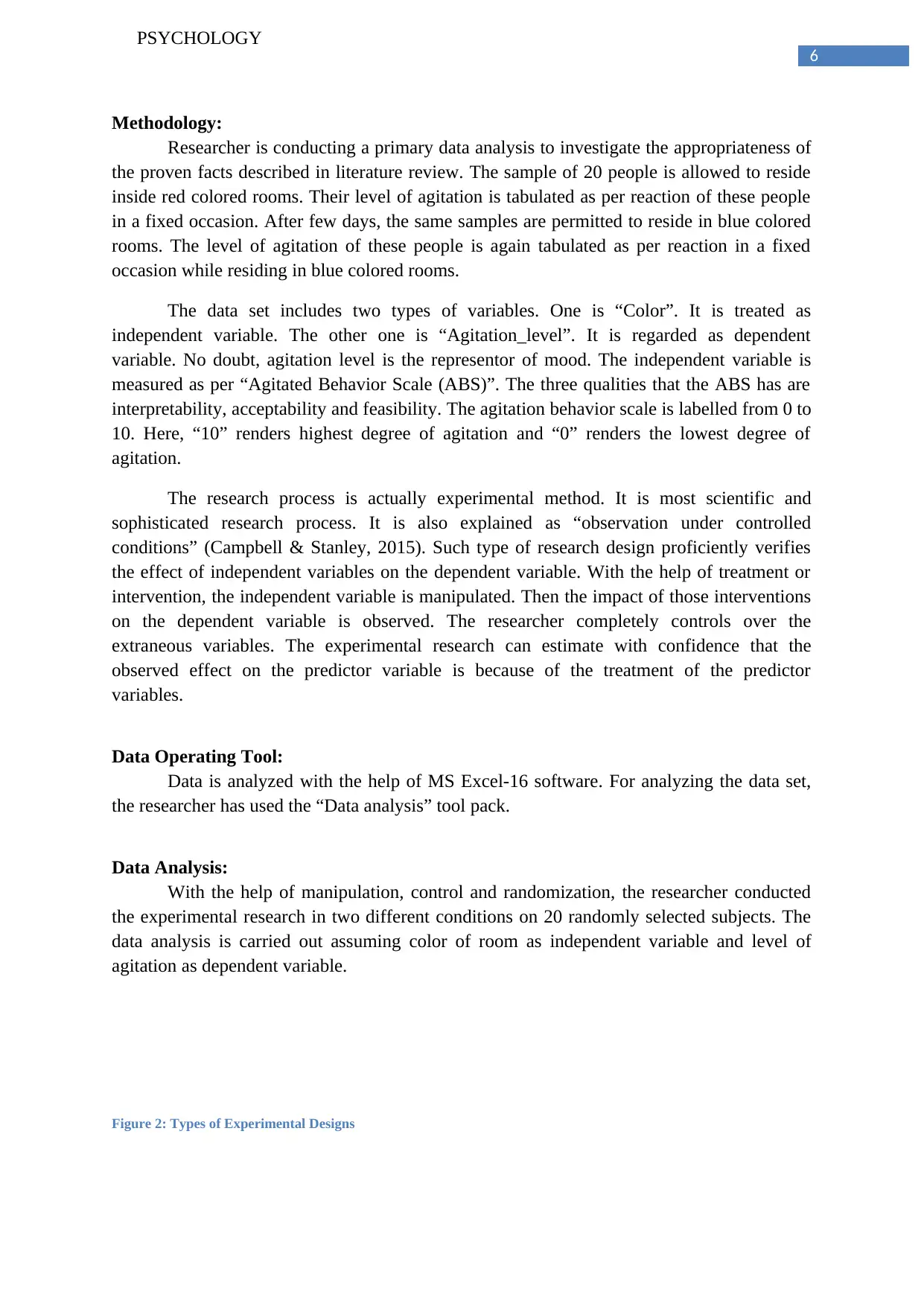
6
PSYCHOLOGY
Methodology:
Researcher is conducting a primary data analysis to investigate the appropriateness of
the proven facts described in literature review. The sample of 20 people is allowed to reside
inside red colored rooms. Their level of agitation is tabulated as per reaction of these people
in a fixed occasion. After few days, the same samples are permitted to reside in blue colored
rooms. The level of agitation of these people is again tabulated as per reaction in a fixed
occasion while residing in blue colored rooms.
The data set includes two types of variables. One is “Color”. It is treated as
independent variable. The other one is “Agitation_level”. It is regarded as dependent
variable. No doubt, agitation level is the representor of mood. The independent variable is
measured as per “Agitated Behavior Scale (ABS)”. The three qualities that the ABS has are
interpretability, acceptability and feasibility. The agitation behavior scale is labelled from 0 to
10. Here, “10” renders highest degree of agitation and “0” renders the lowest degree of
agitation.
The research process is actually experimental method. It is most scientific and
sophisticated research process. It is also explained as “observation under controlled
conditions” (Campbell & Stanley, 2015). Such type of research design proficiently verifies
the effect of independent variables on the dependent variable. With the help of treatment or
intervention, the independent variable is manipulated. Then the impact of those interventions
on the dependent variable is observed. The researcher completely controls over the
extraneous variables. The experimental research can estimate with confidence that the
observed effect on the predictor variable is because of the treatment of the predictor
variables.
Data Operating Tool:
Data is analyzed with the help of MS Excel-16 software. For analyzing the data set,
the researcher has used the “Data analysis” tool pack.
Data Analysis:
With the help of manipulation, control and randomization, the researcher conducted
the experimental research in two different conditions on 20 randomly selected subjects. The
data analysis is carried out assuming color of room as independent variable and level of
agitation as dependent variable.
Figure 2: Types of Experimental Designs
PSYCHOLOGY
Methodology:
Researcher is conducting a primary data analysis to investigate the appropriateness of
the proven facts described in literature review. The sample of 20 people is allowed to reside
inside red colored rooms. Their level of agitation is tabulated as per reaction of these people
in a fixed occasion. After few days, the same samples are permitted to reside in blue colored
rooms. The level of agitation of these people is again tabulated as per reaction in a fixed
occasion while residing in blue colored rooms.
The data set includes two types of variables. One is “Color”. It is treated as
independent variable. The other one is “Agitation_level”. It is regarded as dependent
variable. No doubt, agitation level is the representor of mood. The independent variable is
measured as per “Agitated Behavior Scale (ABS)”. The three qualities that the ABS has are
interpretability, acceptability and feasibility. The agitation behavior scale is labelled from 0 to
10. Here, “10” renders highest degree of agitation and “0” renders the lowest degree of
agitation.
The research process is actually experimental method. It is most scientific and
sophisticated research process. It is also explained as “observation under controlled
conditions” (Campbell & Stanley, 2015). Such type of research design proficiently verifies
the effect of independent variables on the dependent variable. With the help of treatment or
intervention, the independent variable is manipulated. Then the impact of those interventions
on the dependent variable is observed. The researcher completely controls over the
extraneous variables. The experimental research can estimate with confidence that the
observed effect on the predictor variable is because of the treatment of the predictor
variables.
Data Operating Tool:
Data is analyzed with the help of MS Excel-16 software. For analyzing the data set,
the researcher has used the “Data analysis” tool pack.
Data Analysis:
With the help of manipulation, control and randomization, the researcher conducted
the experimental research in two different conditions on 20 randomly selected subjects. The
data analysis is carried out assuming color of room as independent variable and level of
agitation as dependent variable.
Figure 2: Types of Experimental Designs
Paraphrase This Document
Need a fresh take? Get an instant paraphrase of this document with our AI Paraphraser
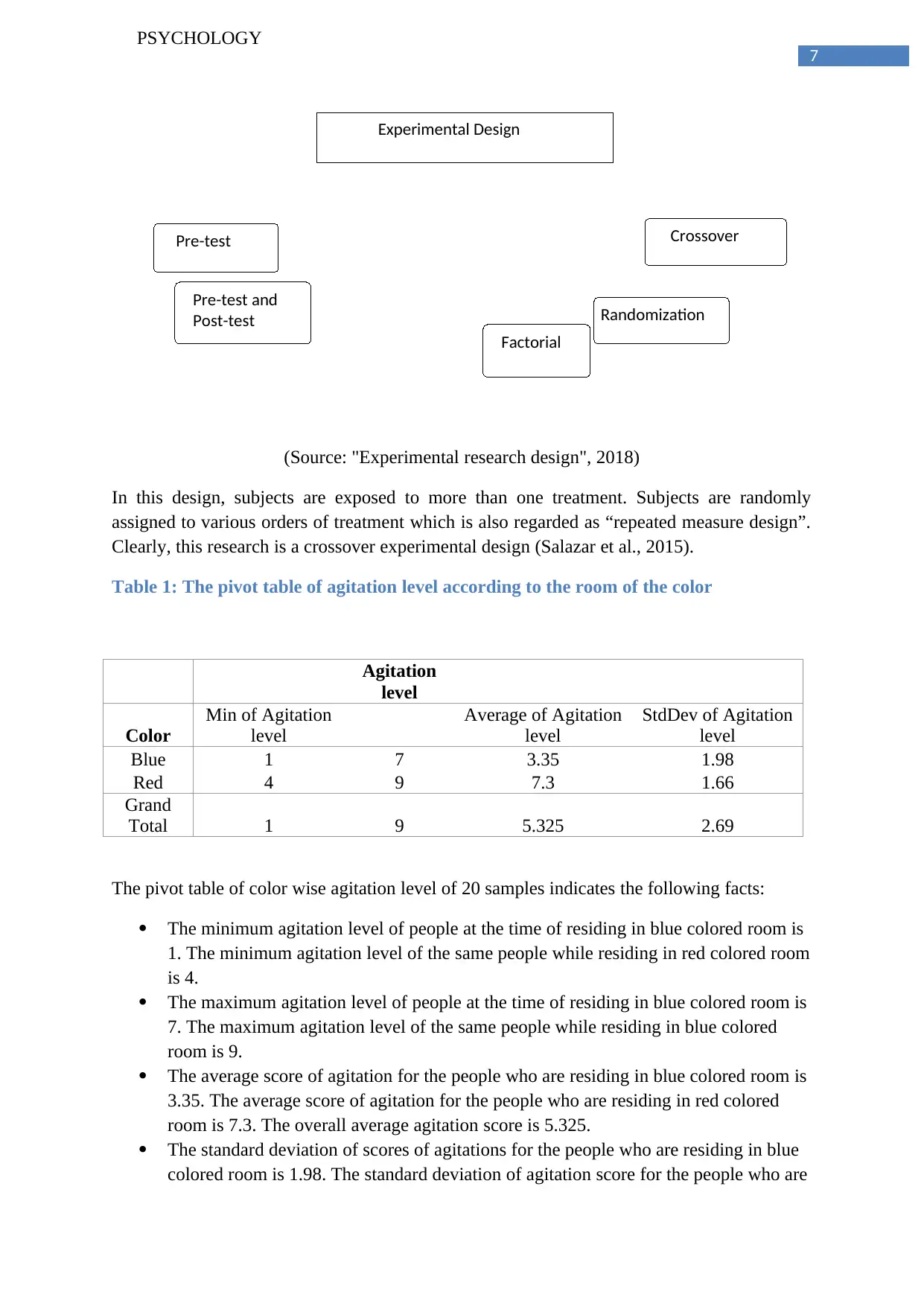
7
PSYCHOLOGY
(Source: "Experimental research design", 2018)
In this design, subjects are exposed to more than one treatment. Subjects are randomly
assigned to various orders of treatment which is also regarded as “repeated measure design”.
Clearly, this research is a crossover experimental design (Salazar et al., 2015).
Table 1: The pivot table of agitation level according to the room of the color
Agitation
level
Color
Min of Agitation
level
Average of Agitation
level
StdDev of Agitation
level
Blue 1 7 3.35 1.98
Red 4 9 7.3 1.66
Grand
Total 1 9 5.325 2.69
The pivot table of color wise agitation level of 20 samples indicates the following facts:
The minimum agitation level of people at the time of residing in blue colored room is
1. The minimum agitation level of the same people while residing in red colored room
is 4.
The maximum agitation level of people at the time of residing in blue colored room is
7. The maximum agitation level of the same people while residing in blue colored
room is 9.
The average score of agitation for the people who are residing in blue colored room is
3.35. The average score of agitation for the people who are residing in red colored
room is 7.3. The overall average agitation score is 5.325.
The standard deviation of scores of agitations for the people who are residing in blue
colored room is 1.98. The standard deviation of agitation score for the people who are
Factorial
Randomization
Crossover
Experimental Design
Pre-test
Pre-test and
Post-test
PSYCHOLOGY
(Source: "Experimental research design", 2018)
In this design, subjects are exposed to more than one treatment. Subjects are randomly
assigned to various orders of treatment which is also regarded as “repeated measure design”.
Clearly, this research is a crossover experimental design (Salazar et al., 2015).
Table 1: The pivot table of agitation level according to the room of the color
Agitation
level
Color
Min of Agitation
level
Average of Agitation
level
StdDev of Agitation
level
Blue 1 7 3.35 1.98
Red 4 9 7.3 1.66
Grand
Total 1 9 5.325 2.69
The pivot table of color wise agitation level of 20 samples indicates the following facts:
The minimum agitation level of people at the time of residing in blue colored room is
1. The minimum agitation level of the same people while residing in red colored room
is 4.
The maximum agitation level of people at the time of residing in blue colored room is
7. The maximum agitation level of the same people while residing in blue colored
room is 9.
The average score of agitation for the people who are residing in blue colored room is
3.35. The average score of agitation for the people who are residing in red colored
room is 7.3. The overall average agitation score is 5.325.
The standard deviation of scores of agitations for the people who are residing in blue
colored room is 1.98. The standard deviation of agitation score for the people who are
Factorial
Randomization
Crossover
Experimental Design
Pre-test
Pre-test and
Post-test
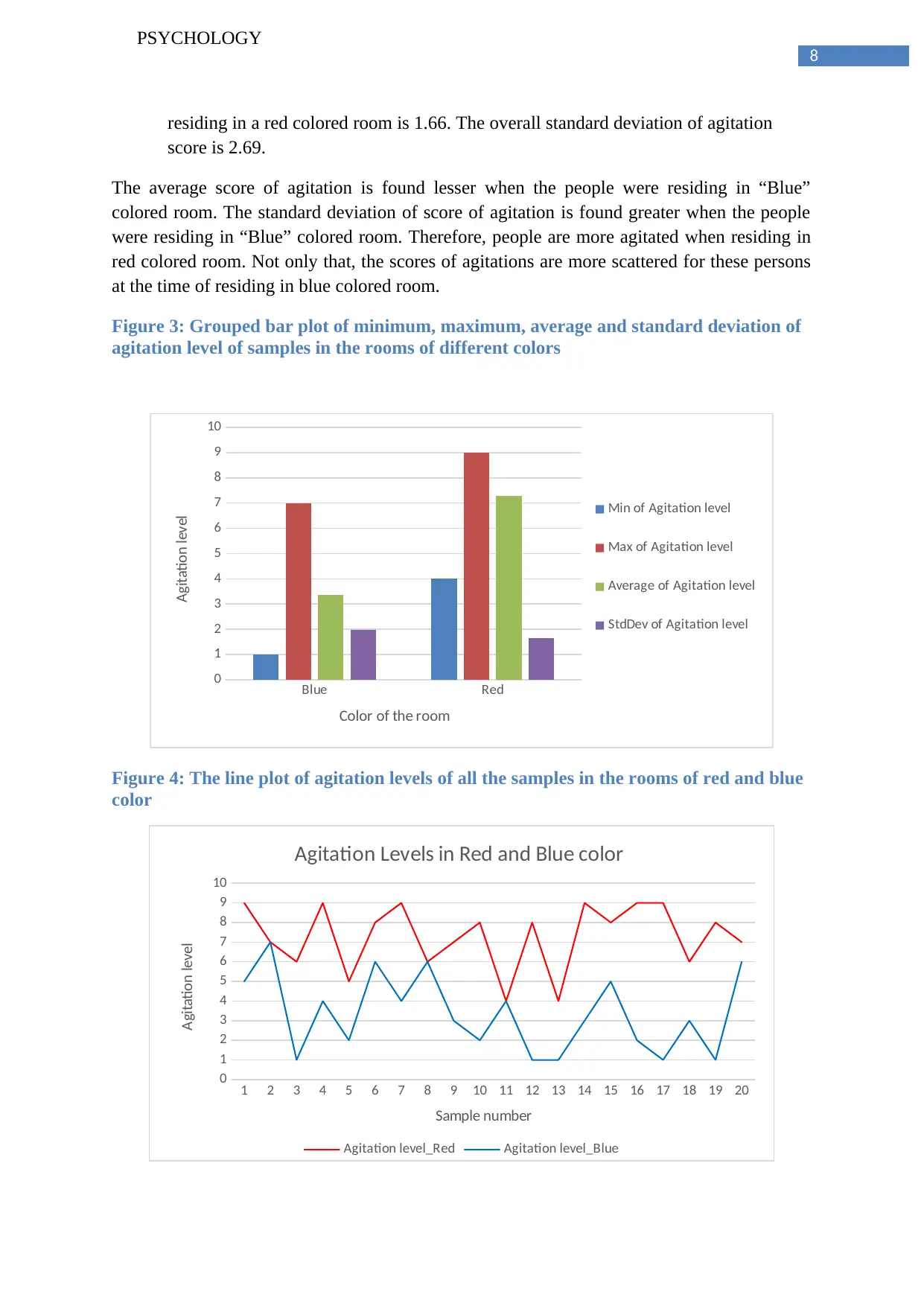
8
PSYCHOLOGY
residing in a red colored room is 1.66. The overall standard deviation of agitation
score is 2.69.
The average score of agitation is found lesser when the people were residing in “Blue”
colored room. The standard deviation of score of agitation is found greater when the people
were residing in “Blue” colored room. Therefore, people are more agitated when residing in
red colored room. Not only that, the scores of agitations are more scattered for these persons
at the time of residing in blue colored room.
Figure 3: Grouped bar plot of minimum, maximum, average and standard deviation of
agitation level of samples in the rooms of different colors
Blue Red
0
1
2
3
4
5
6
7
8
9
10
Min of Agitation level
Max of Agitation level
Average of Agitation level
StdDev of Agitation level
Color of the room
Agitation level
Figure 4: The line plot of agitation levels of all the samples in the rooms of red and blue
color
1 2 3 4 5 6 7 8 9 10 11 12 13 14 15 16 17 18 19 20
0
1
2
3
4
5
6
7
8
9
10
Agitation Levels in Red and Blue color
Agitation level_Red Agitation level_Blue
Sample number
Agitation level
PSYCHOLOGY
residing in a red colored room is 1.66. The overall standard deviation of agitation
score is 2.69.
The average score of agitation is found lesser when the people were residing in “Blue”
colored room. The standard deviation of score of agitation is found greater when the people
were residing in “Blue” colored room. Therefore, people are more agitated when residing in
red colored room. Not only that, the scores of agitations are more scattered for these persons
at the time of residing in blue colored room.
Figure 3: Grouped bar plot of minimum, maximum, average and standard deviation of
agitation level of samples in the rooms of different colors
Blue Red
0
1
2
3
4
5
6
7
8
9
10
Min of Agitation level
Max of Agitation level
Average of Agitation level
StdDev of Agitation level
Color of the room
Agitation level
Figure 4: The line plot of agitation levels of all the samples in the rooms of red and blue
color
1 2 3 4 5 6 7 8 9 10 11 12 13 14 15 16 17 18 19 20
0
1
2
3
4
5
6
7
8
9
10
Agitation Levels in Red and Blue color
Agitation level_Red Agitation level_Blue
Sample number
Agitation level
⊘ This is a preview!⊘
Do you want full access?
Subscribe today to unlock all pages.

Trusted by 1+ million students worldwide
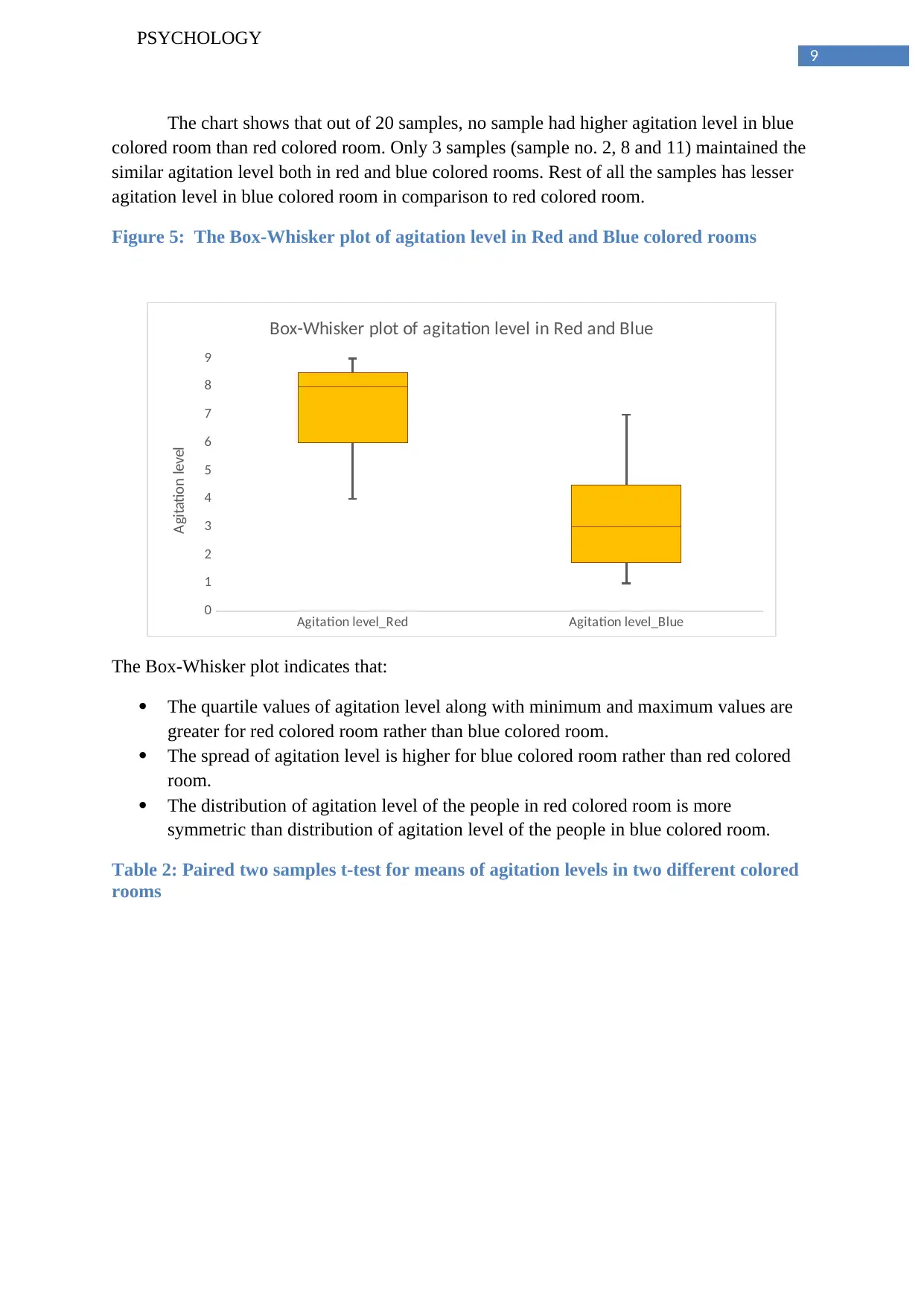
9
PSYCHOLOGY
The chart shows that out of 20 samples, no sample had higher agitation level in blue
colored room than red colored room. Only 3 samples (sample no. 2, 8 and 11) maintained the
similar agitation level both in red and blue colored rooms. Rest of all the samples has lesser
agitation level in blue colored room in comparison to red colored room.
Figure 5: The Box-Whisker plot of agitation level in Red and Blue colored rooms
Agitation level_Red Agitation level_Blue
0
1
2
3
4
5
6
7
8
9
Box-Whisker plot of agitation level in Red and Blue
Agitation level
The Box-Whisker plot indicates that:
The quartile values of agitation level along with minimum and maximum values are
greater for red colored room rather than blue colored room.
The spread of agitation level is higher for blue colored room rather than red colored
room.
The distribution of agitation level of the people in red colored room is more
symmetric than distribution of agitation level of the people in blue colored room.
Table 2: Paired two samples t-test for means of agitation levels in two different colored
rooms
PSYCHOLOGY
The chart shows that out of 20 samples, no sample had higher agitation level in blue
colored room than red colored room. Only 3 samples (sample no. 2, 8 and 11) maintained the
similar agitation level both in red and blue colored rooms. Rest of all the samples has lesser
agitation level in blue colored room in comparison to red colored room.
Figure 5: The Box-Whisker plot of agitation level in Red and Blue colored rooms
Agitation level_Red Agitation level_Blue
0
1
2
3
4
5
6
7
8
9
Box-Whisker plot of agitation level in Red and Blue
Agitation level
The Box-Whisker plot indicates that:
The quartile values of agitation level along with minimum and maximum values are
greater for red colored room rather than blue colored room.
The spread of agitation level is higher for blue colored room rather than red colored
room.
The distribution of agitation level of the people in red colored room is more
symmetric than distribution of agitation level of the people in blue colored room.
Table 2: Paired two samples t-test for means of agitation levels in two different colored
rooms
Paraphrase This Document
Need a fresh take? Get an instant paraphrase of this document with our AI Paraphraser
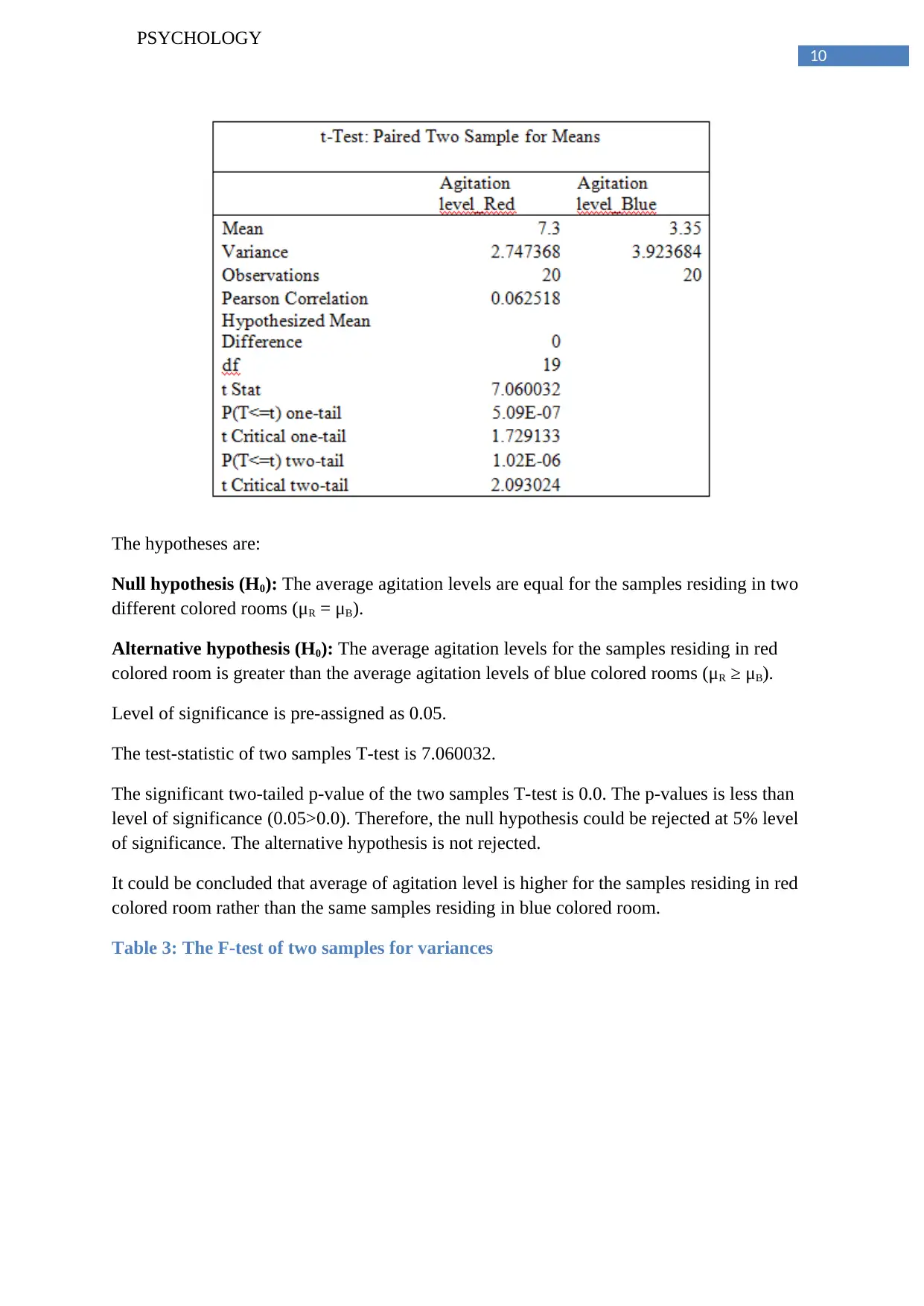
10
PSYCHOLOGY
The hypotheses are:
Null hypothesis (H0): The average agitation levels are equal for the samples residing in two
different colored rooms (μR = μB).
Alternative hypothesis (H0): The average agitation levels for the samples residing in red
colored room is greater than the average agitation levels of blue colored rooms (μR ≥ μB).
Level of significance is pre-assigned as 0.05.
The test-statistic of two samples T-test is 7.060032.
The significant two-tailed p-value of the two samples T-test is 0.0. The p-values is less than
level of significance (0.05>0.0). Therefore, the null hypothesis could be rejected at 5% level
of significance. The alternative hypothesis is not rejected.
It could be concluded that average of agitation level is higher for the samples residing in red
colored room rather than the same samples residing in blue colored room.
Table 3: The F-test of two samples for variances
PSYCHOLOGY
The hypotheses are:
Null hypothesis (H0): The average agitation levels are equal for the samples residing in two
different colored rooms (μR = μB).
Alternative hypothesis (H0): The average agitation levels for the samples residing in red
colored room is greater than the average agitation levels of blue colored rooms (μR ≥ μB).
Level of significance is pre-assigned as 0.05.
The test-statistic of two samples T-test is 7.060032.
The significant two-tailed p-value of the two samples T-test is 0.0. The p-values is less than
level of significance (0.05>0.0). Therefore, the null hypothesis could be rejected at 5% level
of significance. The alternative hypothesis is not rejected.
It could be concluded that average of agitation level is higher for the samples residing in red
colored room rather than the same samples residing in blue colored room.
Table 3: The F-test of two samples for variances
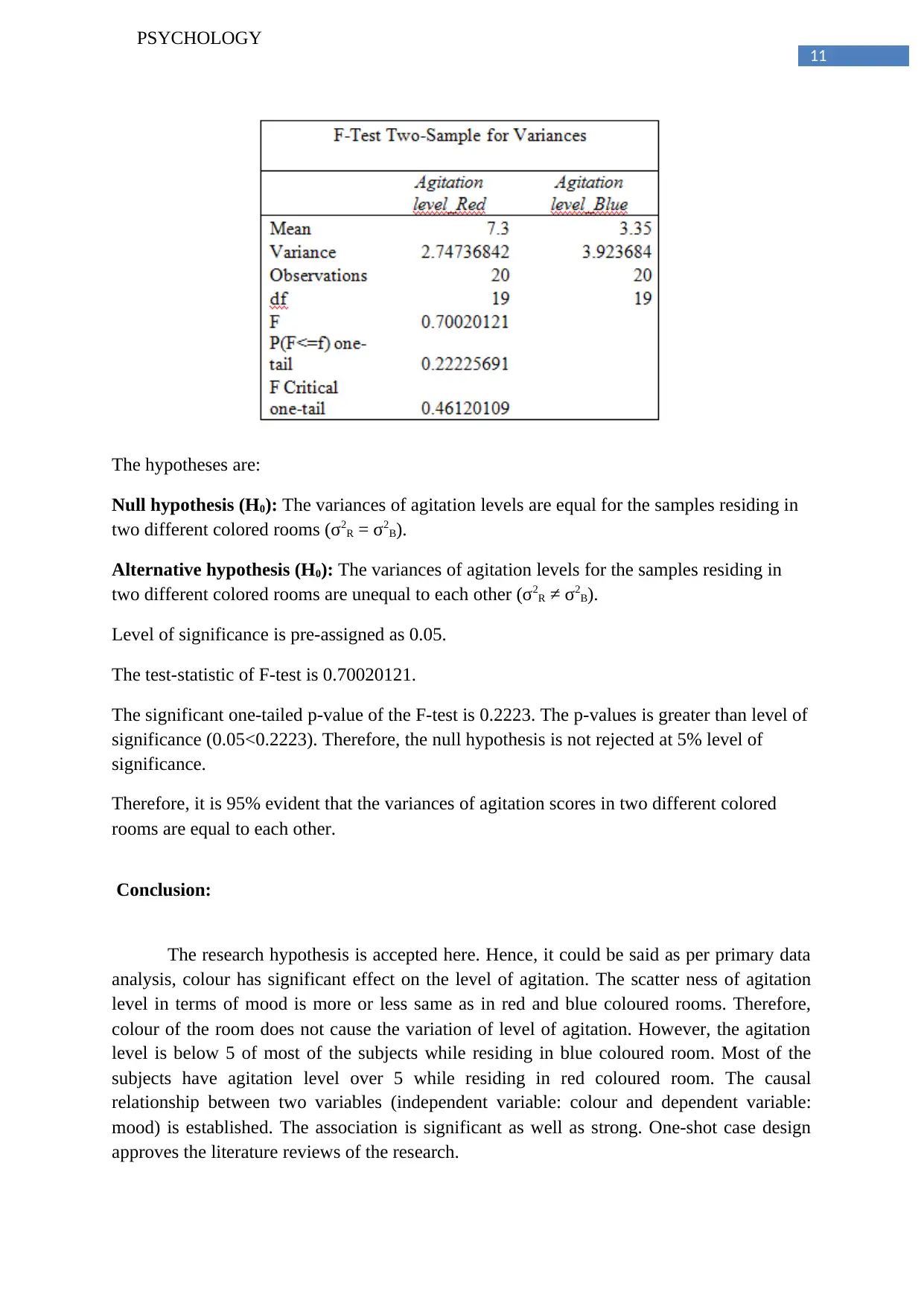
11
PSYCHOLOGY
The hypotheses are:
Null hypothesis (H0): The variances of agitation levels are equal for the samples residing in
two different colored rooms (σ2R = σ2B).
Alternative hypothesis (H0): The variances of agitation levels for the samples residing in
two different colored rooms are unequal to each other (σ2R ≠ σ2B).
Level of significance is pre-assigned as 0.05.
The test-statistic of F-test is 0.70020121.
The significant one-tailed p-value of the F-test is 0.2223. The p-values is greater than level of
significance (0.05<0.2223). Therefore, the null hypothesis is not rejected at 5% level of
significance.
Therefore, it is 95% evident that the variances of agitation scores in two different colored
rooms are equal to each other.
Conclusion:
The research hypothesis is accepted here. Hence, it could be said as per primary data
analysis, colour has significant effect on the level of agitation. The scatter ness of agitation
level in terms of mood is more or less same as in red and blue coloured rooms. Therefore,
colour of the room does not cause the variation of level of agitation. However, the agitation
level is below 5 of most of the subjects while residing in blue coloured room. Most of the
subjects have agitation level over 5 while residing in red coloured room. The causal
relationship between two variables (independent variable: colour and dependent variable:
mood) is established. The association is significant as well as strong. One-shot case design
approves the literature reviews of the research.
PSYCHOLOGY
The hypotheses are:
Null hypothesis (H0): The variances of agitation levels are equal for the samples residing in
two different colored rooms (σ2R = σ2B).
Alternative hypothesis (H0): The variances of agitation levels for the samples residing in
two different colored rooms are unequal to each other (σ2R ≠ σ2B).
Level of significance is pre-assigned as 0.05.
The test-statistic of F-test is 0.70020121.
The significant one-tailed p-value of the F-test is 0.2223. The p-values is greater than level of
significance (0.05<0.2223). Therefore, the null hypothesis is not rejected at 5% level of
significance.
Therefore, it is 95% evident that the variances of agitation scores in two different colored
rooms are equal to each other.
Conclusion:
The research hypothesis is accepted here. Hence, it could be said as per primary data
analysis, colour has significant effect on the level of agitation. The scatter ness of agitation
level in terms of mood is more or less same as in red and blue coloured rooms. Therefore,
colour of the room does not cause the variation of level of agitation. However, the agitation
level is below 5 of most of the subjects while residing in blue coloured room. Most of the
subjects have agitation level over 5 while residing in red coloured room. The causal
relationship between two variables (independent variable: colour and dependent variable:
mood) is established. The association is significant as well as strong. One-shot case design
approves the literature reviews of the research.
⊘ This is a preview!⊘
Do you want full access?
Subscribe today to unlock all pages.

Trusted by 1+ million students worldwide
1 out of 15
Your All-in-One AI-Powered Toolkit for Academic Success.
+13062052269
info@desklib.com
Available 24*7 on WhatsApp / Email
![[object Object]](/_next/static/media/star-bottom.7253800d.svg)
Unlock your academic potential
Copyright © 2020–2025 A2Z Services. All Rights Reserved. Developed and managed by ZUCOL.

